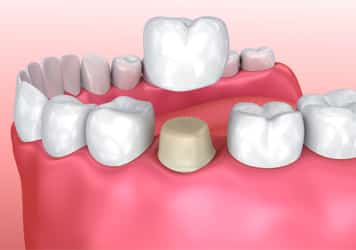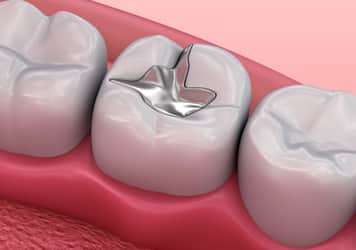

Crowns
A crown, sometimes referred to as a cap, is used to restore and enhance teeth that are heavily damaged. A tooth-shaped “cap” is placed over the base of a tooth to restore its shape, size, and strength. The crown fully covers the visible portion of the tooth above the gum line.
Why would a crown be used?
- To protect a weak tooth damaged by decay or trauma
- To restore an already broken tooth
- To provide support to a tooth with a very large filling when there isn’t a lot of the tooth left
- To hold and support a dental bridge
- To make cosmetic modifications
- To cover a dental implant
There are several options available for the material your crown is made of including ceramic, porcelain, resin, and stainless steel. Talk to your dentist to determine which is best for you.
Placing a crown generally takes two office visits. Your first visit will be to prepare your mouth and tooth. After a thorough examination of the tooth to ensure it can support a crown, the tooth will be filed down to make room for the crown to be placed over it. In severe decay or damage cases, the tooth may need to be filled in to provide the crown a stable base to be placed on. Once the tooth is prepped, an impression of the tooth and surrounding teeth will be taken. The impression will be sent to our lab where they will use the latest technology to craft your crown. Your dentist will place a temporary crown while you are waiting for your new one.
You will have your follow-up visit when your crown is ready. Your temporary crown will be removed and replaced with your new permanent crown. A specialized adhesive is used to securely fasten the crown in place. Follow your regular oral hygiene routine to properly care for your new crown.
Fillings
Fillings are commonly used to repair the function and shape of a tooth that has been damaged by decay or trauma. The damaged portion of the tooth will be precisely removed leaving as much healthy tooth remaining as possible. The resulting void in the tooth will then be cleaned out and filled. The filling will help stop further decay by sealing off any cracks or crevices where bacteria could enter. There are several filling materials available with their own set of pros and cons. Your dentist will help you determine the best choice for you based on several factors.
Types of fillings:
- Amalgam- Amalgam fillings have been used by dentists for over a century. Their durability and low cost have made them the filling of choice since the advent of modern dentistry.
- Metals- Gold and silver amalgams are the most common metal fillings.
- Composite- Sometimes referred to as filled resins, these fillings can be made to match the natural color of your teeth.
- Ceramic- A ceramic filling is tooth-colored and may be less likely to show tooth stains over time.
What to expect during your filling procedure?
- Your dentist will use a local anesthesia to numb the area around the tooth to make the procedure as painless as possible.
- A drill or laser instrument will be used to remove the decayed area.
- The area will be cleaned of all bacteria and debris.
- After filling with your material of choice, the filling will be shaped and polished to fit the natural contours of your mouth.
The entire process of getting a filling will take about an hour. Depending on the filling material, your filling can last from 5-15 years. And just like the rest of your teeth, how long they last is directly impacted by your overall oral hygiene. Make sure you are brushing and flossing every day and attending your regularly scheduled checkups with your dentist.
